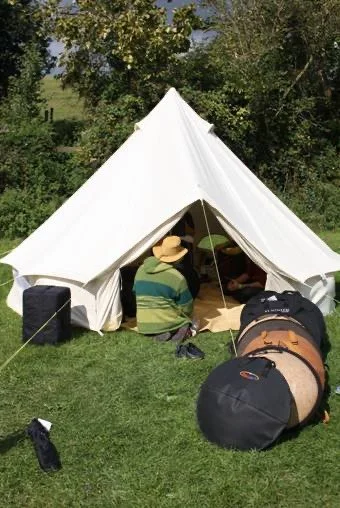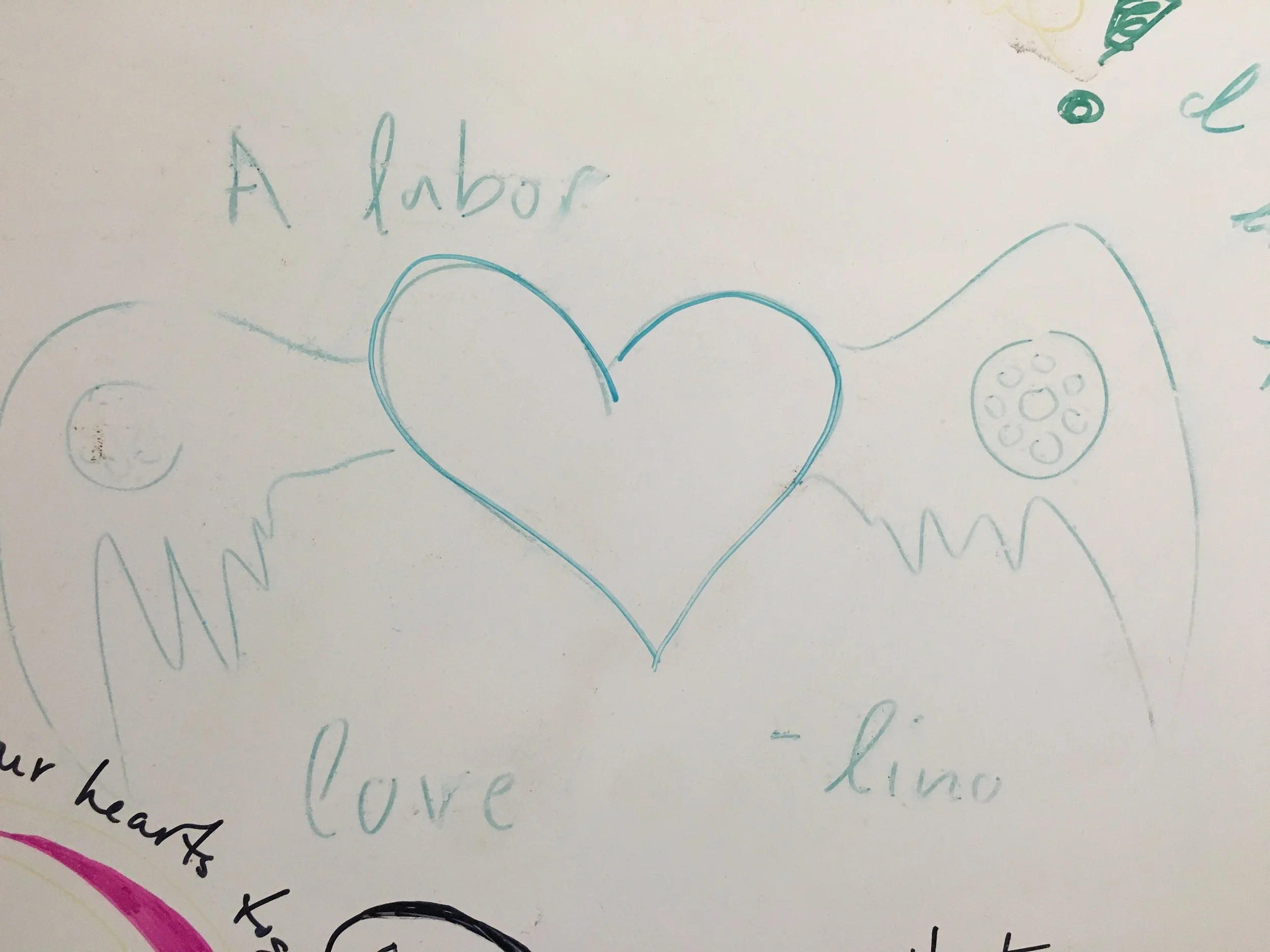Linotune - A Living Legacy
Fifteen years ago, a single moment of frustration ignited a revolution in the world of handpans—one that would transform the craft forever. By fate or good fortune, I was among the few who witnessed it firsthand. This is the story of Linotune.
HangoutUK, the world’s longest-standing handpan gathering, was at the epicenter of it all. I was one of four Americans in attendance in 2010—wide-eyed, ecstatic, and ready to immerse myself in a community that, until then, had only existed through online forums and YouTube videos.
But as the first day unfolded, one thing became clear: there was a serious need for retuning. Instruments, both young and old, were in dire need of an experienced tuner. And for the first time in the event’s history, a professional tuner was in attendance. Kyle Cox of Pantheon Steel came prepared to put hammer to steel.
At the time, a mechanical strobe tuner was the industry standard. Developed before WWII, this technology saw little change over the decades. The smallest was the size of a shoebox. The largest? A double-thick briefcase. Each housed a spinning wheel in front of a blinking lightbulb—heavy, sensitive, and far from travel-friendly.
An industry leader's recent launch of an iPad app claimed it could replace mechanical devices. Why not trade in the hefty carry-on for a sleek modern tablet? Kyle left his strobe tuner at home and packed his iPad, anticipating that he was stepping into the future of tuning.
The app was a flop—a supposed leap forward that proved to be two steps back. A tuner without a tuning device is akin to a boat adrift. One could start to paddle, but in what direction, for how long, and to what end
Frustrated, Kyle abandoned the app. For the rest of the day, he was stranded without a proper tuning tool. Serendipitously, a strobe tuner appeared at the festival in the hands of an aspiring tuner the next day. Unfortunately, it was a model Kyle had never used before. The problem wasn’t solved—it had only changed shape.
Had that iPad app performed better or had it been a strobe tuner that Kyle was familiar with, a seed of frustration wouldn’t have been planted that weekend. What no one knew at the time was that along with that seed of frustration, a seed of inspiration had been planted too.
The historic event ended, and attendees dispersed back across the globe, charged by the gathering. I had one night until I jetted home, but my lodging plans fell through. An offer from Kyle, my fellow American, to stay with the Pantheon crew for one night before they flew back to headquarters was a relief. Plus, who wouldn’t want some one-on-one time with a handpan maker?!
Unbeknownst to me, another guest would be joining us. A German computer programmer. A fellow elite handpan geek. A man named Lino.
We had seen some of Lino’s work on the forums—nifty generated visuals for chords found on handpans and other geekery that we all swooned for. Lino and I had studied at the same university a decade apart and, while we had both attended courses in the mathematics hall, it was our shared love of its resonant 8-story cement stairwell that left a mutual impression. Burned out from his academic career, Lino was taking some time to refocus his life.
That night, at an airport hotel bar, I found myself at a table where I wasn’t sure I belonged. Kyle, a seasoned tuner with deep steelpan roots. Jim Dusin, his business partner—a retired go-go-gadget MacGyver engineer. I did my best to keep up but I was punching way above my weight class.
But as the evening unfolded, I realized I belonged there more than I thought. I was a passionate, obsessive, and enthusiastic newbie who flew halfway around the world to cannonball into the deep end. I was a current community representative at this meeting of the minds, a perspective that was welcomed and encouraged.
The conversations flowed from our shared experience of our first festival to the current state of the art form and where we believed it was heading. Kyle eventually vented his frustration about the iPad app, listing its flaws and unmet promises and the regret he felt around his decision to abandon his strobe tuner.
Lino had witnessed Kyle’s frustration with the app and subsequent frustrations even when the strobe tuner arrived. As Lino began to understand how a strobe tuner functioned and how the app fell short, it dawned on him that this was a problem he could find a solution to. Then, Lino said something that changed everything.
I could make you a better app.
A pause. Skeptical glances were exchanged around the table. Could he really? It seemed like an impossible promise. The evening continued, the conversation moved on, and the next morning, we all went our separate ways. I didn’t give a second thought to Lino’s claim.
Two weeks later, he had proof of concept, converting mechanical to digital, and slamming previously incalculable data into a seamless computer window. Lino’s unique background, combined with his passion for handpans, supported a vision only he could see. He was able to apply his analytical mind and his talent for computer programming, giving his life a new focus. I have no idea how he brought it to fruition so quickly; some sort of digital wizardry, his own form of a dark art.
Lino emailed his proof of concept video to Kyle with the question, “Is this any good?”
Kyle’s response: “DO IT!”
Not long after, Kyle had the beta version of what we now call Linotune. Kyle told me that it was on that day he packed up his strobe tuner and never used it again—calling it a thousand-dollar paperweight.
Six months later, I witnessed Linotune in the wild. A chance tuning trip brought Kyle to Los Angeles and there it was.
Green and orange bars danced across the screen, instructing hammer blows.
No spinning wheels.
No flashing light bulbs.
Just a laptop and a revolution in motion.
In less than a year since that fortuitous dinner in London, Linotune was publicly released.
One year later, Kyle returned to HOUK. This time, he was ready. The industry’s newest tuning technology was running smoothly on his laptop. Linotune wasn’t just an experiment anymore—it was the new standard. The world just didn’t know it yet.
For four days, from breakfast to dinner, Kyle tuned. Outside his tent, an endless queue of instruments patiently waited for their turn. Ten years of drift reset in less than an hour. Dull and tragically damaged instruments entered the tent, and shiny, good-as-new instruments emerged. This man from Missouri could conjure black magic with his hammer and this unknown computer program, leaving attendees in awe.
While Kyle found his stride, it was clear that this was going to be a marathon of tuning. A collective unconscious decision was made to ensure our courageous tuner had the necessary fuel to keep swinging the hammer.
A plate of food, a homemade cookie, or a cold cider would appear, left by the thankful and indebted. He was encouraged to take breaks and stretch his legs, but he hammered on.
I can see now that watching Kyle tune planted a seed of inspiration in me too. Not long after, I decided to make my attempt at learning to tune, leaning heavily on Linotune for support. Fast forward three years, it was I who recorded the Linotune tutorial—a guide on how to use and wield this amazing program.
At some point, Kyle jokingly called me a new-age tuner, noting that I had never relied on a mechanical strobe tuner. Explaining the time before Linotune is like trying to explain to today’s youth what it was like before YouTube or cell phones. For those who came after, it’s simply the way things have always been.
The new-age tuner comment got under my skin in just the right way. I devoted a year to understanding and working with mechanical tuners, amassing a historic collection of these outdated machines. I earned that merit badge, and in doing so, not only did I get to thumb my nose at Kyle, but I gained a significantly deeper appreciation for Lino’s work.
We were making sparks with a flint, and Lino handed us a flamethrower.
Linotune catapulted us from the Stone Age into the digital era, replacing the bulky and fragile mechanical tuners with a portable, hyper-precise, digital interface that now can run on the phone in my pocket.
I've since had the chance to thank Lino. I shook his hand and told him how his program changed my life. In the darkest moments in my arc of learning to tune, it was always there, ready to offer me lessons, whether I wanted them or not. His flashing numbers and shimmering bands were a beacon when all hope had been lost. At a time when there were no teachers, I was shaped by Lino’s genius. Lino has accused me of being the most complex user of his beloved creation, which I take as the highest of compliments.
Beyond the impact of his program, Lino left me inspired to expand beyond what I thought was possible. Although different, I too had a unique set of skills, that when focused and applied to our beloved art form, gave way to new and exciting developments.
Burnt out on academia, he pivoted into a new passion and made a career out of it. His fearless approach to improving what was already thought polished left a lasting impression. And to think, we both attended classes in the same mathematics building but it was the acoustics of the stairwell that left its mark.
By chance or sheer dumb luck, I had a seat at that table in London to witness history. Fifteen years later, I reflect on that moment with profound gratitude. Linotune wasn’t just a computer program—it was a paradigm shift. The accessibility of his program, just one click to download, inspired so many to pick up the hammer. A revolutionary tool that redefined the art of tuning and became a cornerstone for tuners worldwide.
But beyond the program, I value Lino—the man behind the magic. He transformed frustration into innovation and in doing so, created an unquantifiable contribution. His legacy echoes in every note played, touching countless lives the world over.
Lino was responsible for ushering in a golden era by inspiring a new generation of tuners and providing the tool that helped them elevate the craft to levels of precision once thought unimaginable. As a community, we are forever indebted. As an individual, I am forever thankful.
If you’ve read this far, chances are there’s a handpan in your life. And I’d bet the house it was Linotuned.
Here’s to Lino—the man who tunes the tuners.
I raise my hammer to you, my friend.
Thank you.
C.Foulke



